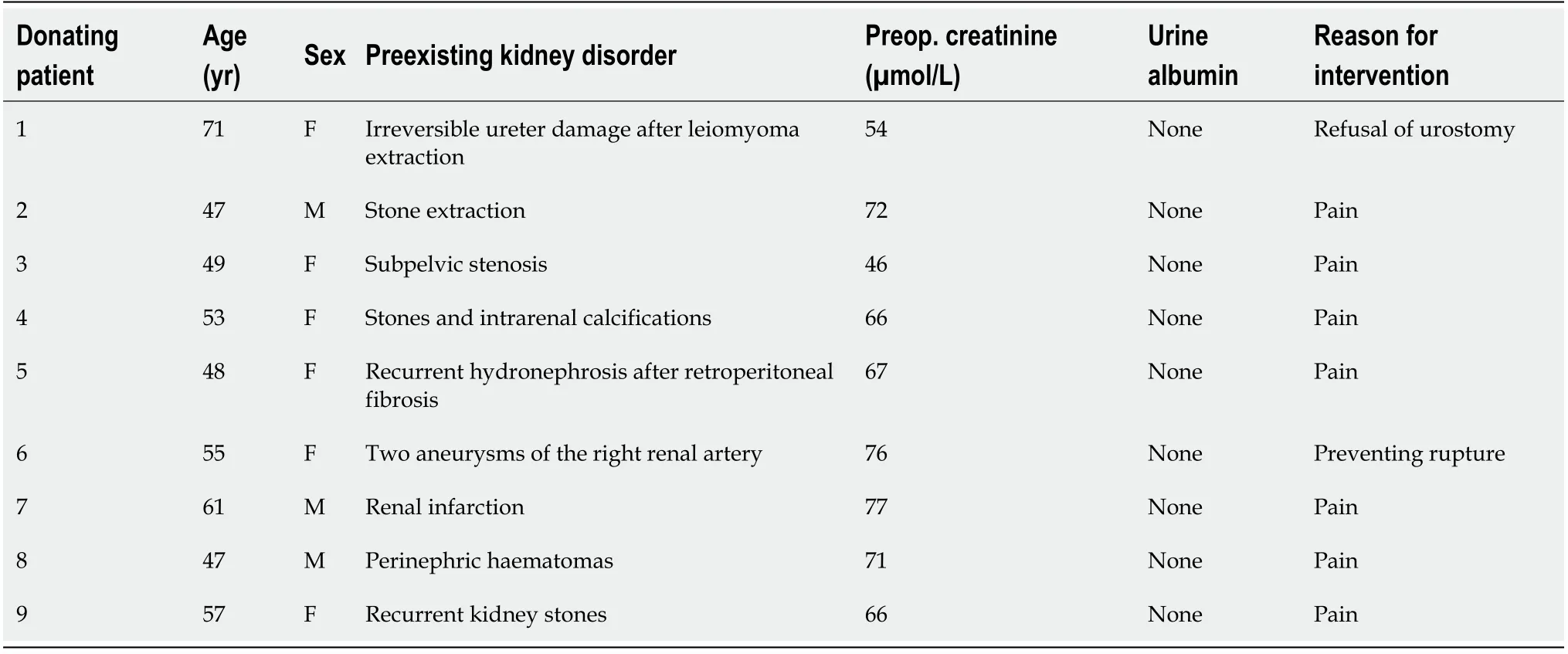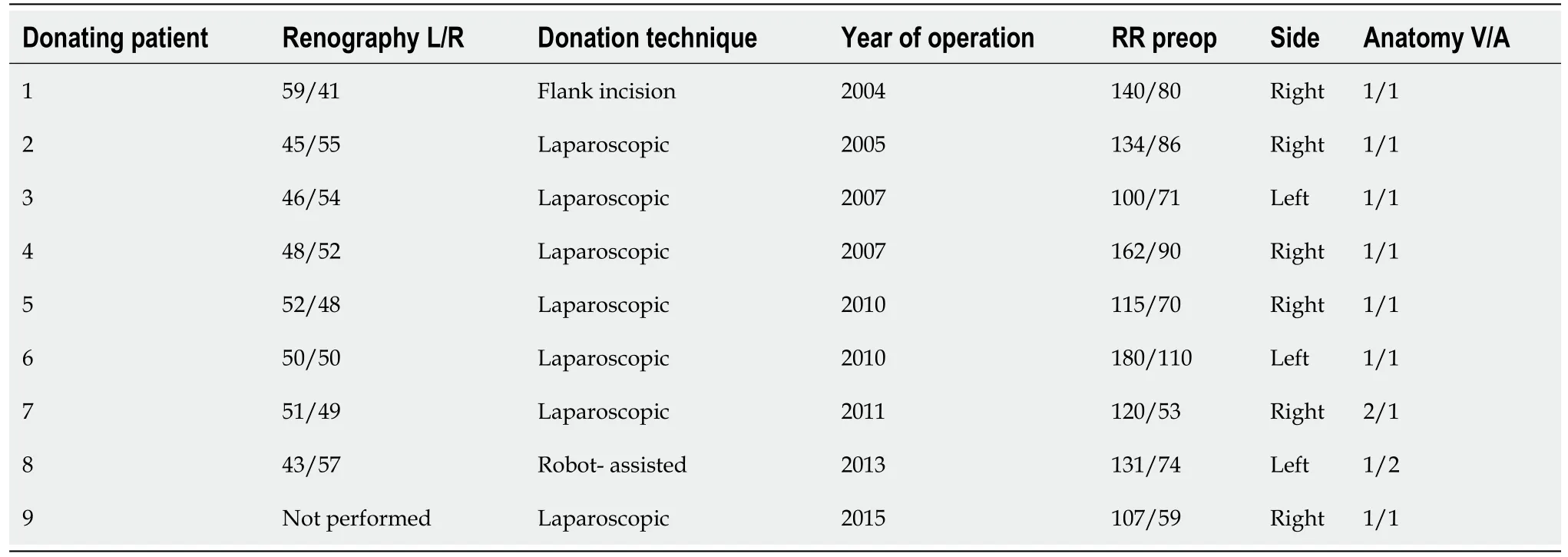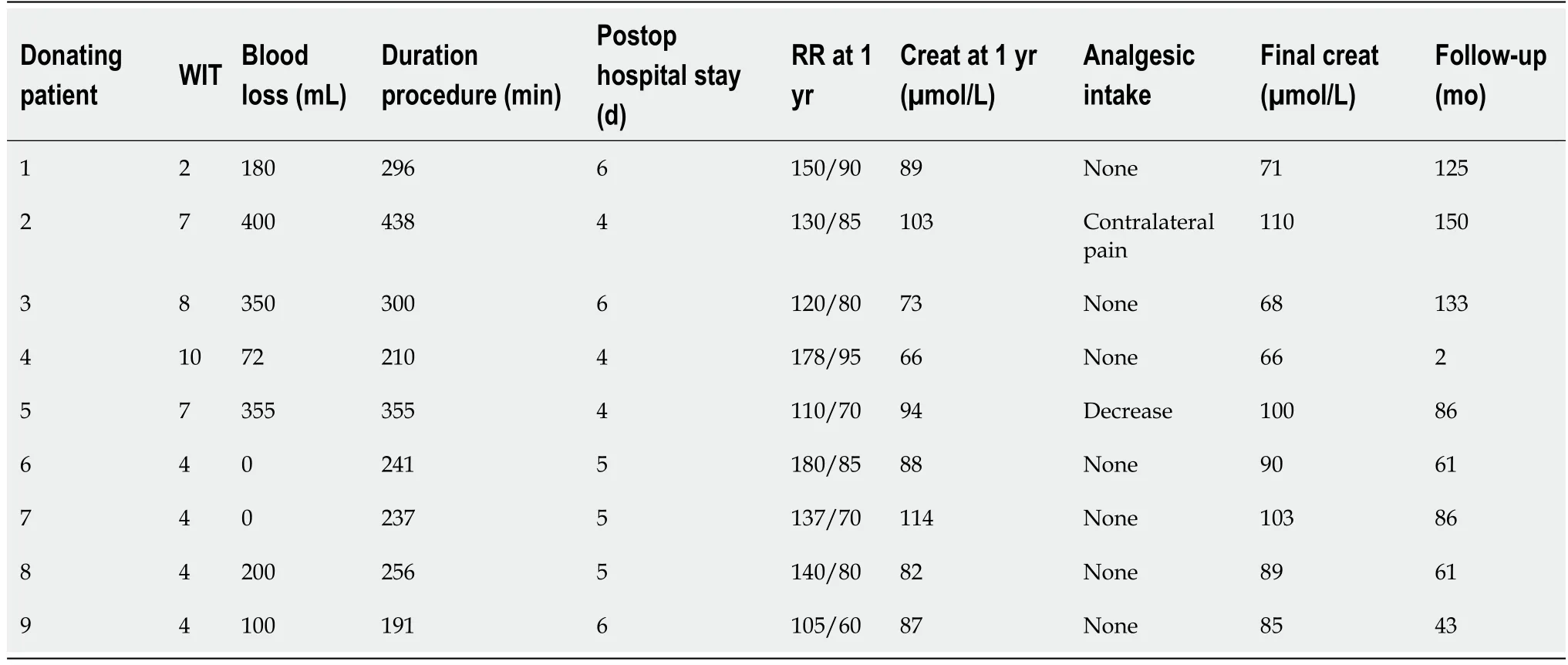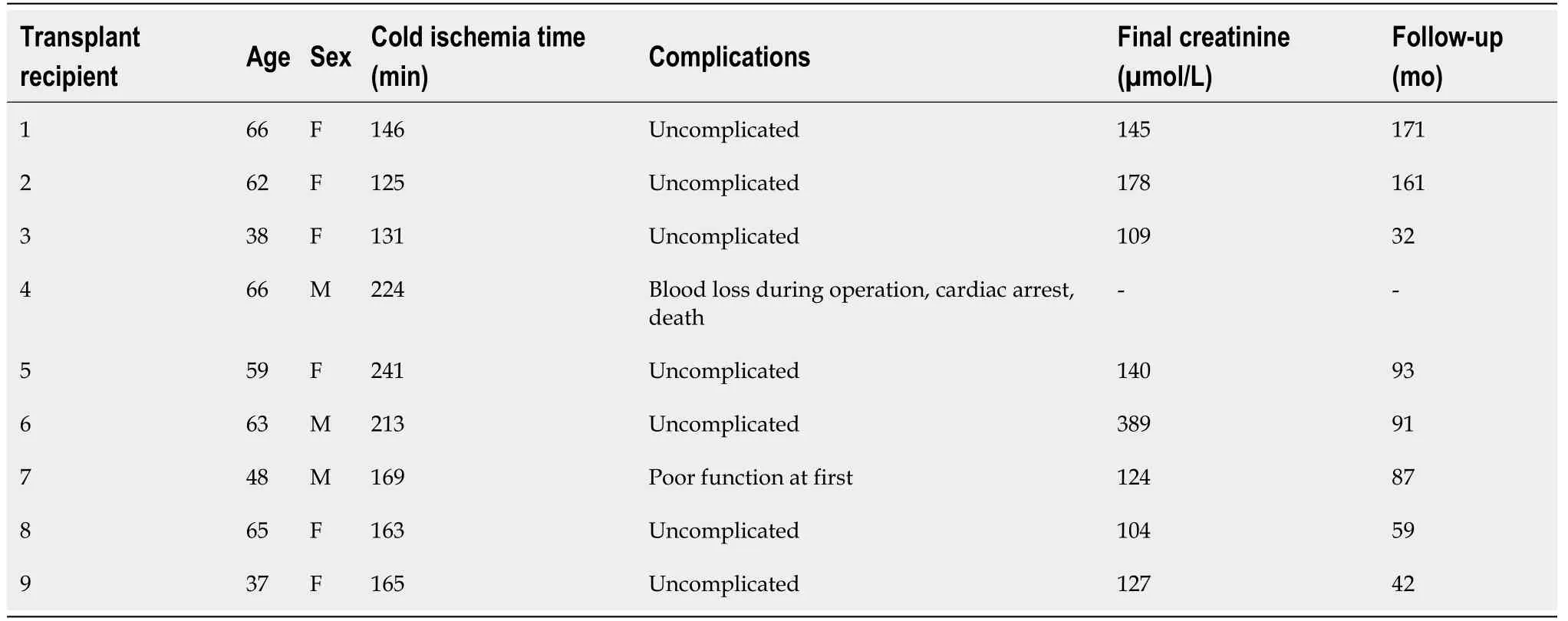Unspecified live kidney donation by urological patients
Sebastiaan Ceuppens,Hendrikus J A N Kimenai,Karel W J Klop,Willij C Zuidema,Michiel G H Betjes,Willem Weimar,Jan N M IJzermans,Frank J M F Dor,Robert C Minnee
Abstract BACKGROUND Individuals with benign kidney disorders undergoing nephrectomy have three possibilities:Autotransplantation,with a certain risk of complications,but without a clear benefit;discarding the kidney;or living kidney donation. AIM To investigate whether patients with benign kidney disorders and a medical indication for nephrectomy are suitable as unspecified live kidney donors. METHODS We searched all clinical data from 1994-2019 for unspecified donors and their transplant recipients (n = 160).Nine of these 160 donors had pre-existing kidney disorders necessitating nephrectomy and had decided to donate their kidney anonymously after discussing the possibility of kidney donation.We studied the clinical course of these nine donating patients and their transplant recipients. RESULTS Seven of nine donating patients indicated unbearable loin pain as the main complaint,one donating patient refused ureterocutaneostomy and one had two aneurysms of the renal artery.Postoperatively,seven donating patients described absence of pain and one a significant reduction after the nephrectomy.The average 1-year creatinine level in the donating patients was 88 µmol/L and after a median of 6.9 years the average creatinine level was 86.6 µmol/L.In the transplant recipients,one major complication occurred which led to death and in one transplant recipient graft function failed to normalize at first but has been stable for nine years now.Currently,all transplant recipients are off dialysis. CONCLUSION Our data show that patients undergoing nephrectomy as part of treatment in selected kidney disorders can function as live kidney donors.
Key words:Unspecified donor;Live kidney donation;Benign kidney disorder;Living donors;Kidney;Transplantation
INTRODUCTION
Since the first successful kidney transplantation there have been many efforts to increase the available pool of donors.Within the field of living kidney donation several initiatives have provided options for expansion.Examples are the Dutch national kidney paired exchange program,and unspecified donation[1-3].The latter has the potential to be expanded even further,as it has been described by several authors for seriously ill patients as unspecified donors[4-7].We hypothesized that patients,diagnosed with a benign kidney disorder that does not impair renal function,but still requires nephrectomy as treatment,may be suitable as live kidney donors,as this has not yet been described in a cohort group.
If nephrectomy is indicated in such patients,there are three options for the resected organ.Firstly,the organ could be discarded,which seems a waste considering the kidney is functioning perfectly.The second option would be an autotransplantation(AutoTx) to preserve the renal function of the patient.Although this is a plausible solution,it requires an additional surgical procedure in the patient,resulting in higher intraoperative complication rates and morbidity[8-12].The third option is an unspecified donation (anonymous donation to a stranger),of the resected kidney to an end-stage renal disease patient,possibly by inclusion in a domino-paired exchange chain to enable more than one transplant[13].This would be an option if the patient meets the standard criteria for living kidney donation and work-up does not show contraindications.As shown by Ibrahimet al[14],there is no decrease in life expectancy or quality of life after live kidney donation;therefore,making an AutoTx unnecessary.We hereby present our initial experience with this type of donation.We searched all clinical data in our live kidney donation program from 1994-2018 for unspecified kidney donors and their transplant recipients (n= 160).Nine of these donors (6%) had pre-existing benign kidney disorders with a medical indication for nephrectomy.We examined the clinical course of these donating patients and their transplant recipients.Between April 2004 and January 2019,9 unspecified donors had donated a kidney at the Erasmus MC,realising a total of 12 transplantations (9 unspecified donors and 3 cross-over donors).
MATERIALS AND METHODS
We searched our donor database from the start of the living donor kidney transplant(LDKT) program in 1994 until January 2019.All donations classified as “altruistic donation” (nowadays called “unspecified” donation) were examined,as well as the recipients of their kidneys.The data on all unspecified donors were examined for the indication for nephrectomy due to pre-existing kidney disorders.Among the unspecified kidney donors,seven cases were referred to us by specialists other than surgeons (urologists,gynaecologists or nephrologists),with urological indications for nephrectomy.The choice for nephrectomy and donation was made in consultation with the specialist after the different options were extensively discussed.The age,sex,type of kidney disorder,preoperative renal function and the reason for intervention stated by the referring specialist in all 9 donating patients were recorded.Moreover,we conducted a mercaptoacetyltriglycine-3 scan as part of our centre protocol and studied the side and type of nephrectomy and preoperative blood pressure.Furthermore,we studied the warm ischemia time,blood loss during the procedure,duration of the procedure,postoperative complications,hospital stay,pain reduction(if relevant),and renal function at 1 year postoperatively and last recorded follow-up.All donating patients had normal renal function preoperatively and met the standard criteria for living kidney donation.In our centre,unspecified donors receive a standard work-up,which included the provision of educational material on living donation.All donating patients had appointments with a nephrologist,a transplant coordinator,and a social worker before being reviewed by a transplant surgeon and an anaesthesiologist.In addition,potential unspecified donors participated in an interview with a clinical psychologist[15,16].As a medical indication for nephrectomy was the main intervention and because the kidney could still be a potential donor kidney after nephrectomy following consent from the donor,the motivation for donation did not have to be reviewed and therefore no psychological evaluation was performed preoperatively in these cases.All donating patients had a final evaluation in a multidisciplinary team meeting.
RESULTS
Donating patients
Seven of the nine donating patients underwent a laparoscopic donor nephrectomy,which has been the gold standard since 1998 in our centre.The procedure was as described by Koket al[17].One donating patient,with irreversible ureter damage after leiomyoma extraction,underwent a donor nephrectomy through a right-sided classic lumbotomy due to extensive retroperitoneal fibrosis.The final donating patient underwent a robot-assisted left side donor nephrectomy.The surgical procedures and postoperative courses in the donating patient group were all uneventful.
All data were gathered in January 2019.All kidneys were transplanted between 2004 and 2015.Median donating patient follow-up was 6.9 years.All nine donating patients donated their kidney for medical reasons as described earlier.The reasons for nephrectomy varied,but seven of nine donating patients indicated unbearable loin pain as the main complaint.Nephrectomy was primarily planned regardless of donation.All kidneys from these donating patients retrospectively demonstrated macroscopically abnormal features compatible with the urological diagnosis.One donating patient refused an ureterocutaneostomy after irreversible iatrogenic damage to the ureter during excision of a retroperitoneal leiomyoma (Table 1).
All perioperative outcome measures during donor nephrectomy (such as ischemia times,skin-to-skin times,blood lossetc.) were comparable to average values in our entire population (Table 2)[18].No anatomic abnormalities were observed regarding the kidney or surrounding tissue when extracted.
One donating patient described a significant reduction and seven a complete absence of pain,reflected in their analgesic intake reduction early after surgery(Table 3).
The average serum creatinine level after 1-year for the donating patients was 88µmol/L,which was well within the normal range and after a median of 6.9 years the average creatinine level in the donating patients was 86.6 µmol/L.All kidneys were successfully implanted in the allocated transplant recipients.One donating patient died after 3.2 years due to an ischemic stroke;however,this was unrelated to donation.

Table 1 Preoperative results

Table 2 Perioperative results
Transplant recipients
In the transplant recipients,one major complication occurred (Table 4).On the first postoperative day,this transplant recipient developed a major myocardial infarction after significant perioperative blood loss.The transplant recipient was not susceptive to resuscitation and died.In the remaining transplant recipients,one graft failed to reach its proper potential with a disappointing creatinine level of over 300 µmol/L.This donor kidney had a preoperative graft infarction.Before accepting this kidney for donation,a radioisotope renography was performed to evaluate the quality of the affected kidney.No anomalies were detected.However,during the last check-up the transplant recipient had a stable creatinine level of 124 µmol/L.Follow-up of the transplant recipients ranged from 2.6 to 14.3 years,with a median of 7.7 years and an average creatinine level of 164.5 µmol/L.Moreover,all transplant recipients are currently off dialysis.
DISCUSSION
The continuing problem of donor shortage across Europe increases the need for live kidney donation.In the early days of live donation,the donor and transplant recipient were mostly genetically related;however,the emphasis is now shifting towards genetically unrelated and even unspecified donations.Expanding the donor pool is justified in light of the excellent results of LDKT reported worldwide.Already,the change in criteria with regard to age and comorbidity has resulted in a much larger potential donor pool,without compromising outcome[19].We can propose a new type of living kidney donor,the urological,gynaecological or surgical patient requiring nephrectomy,who nonetheless has good renal function.After proper screening,these patients can be encouraged to donate their kidney as an unspecified donor.We are the first group to present this type of cohort,and only two similar cases have been presented in the available literature[20].

Table 3 Postoperative results

Table 4 Transplant recipient results
The results showed that all donating patients had appropriate treatment for their respective diseases.Long-term outcome with respect to kidney function (1-year serum creatinine and last follow-up creatinine) was excellent (Table 3).The kidneys removed from the urological patients,that would otherwise have been discarded,were now successfully transplanted into patients with end-stage renal disease,offering them improved quality of life and much better life expectancy compared to dialysis[21].
The only kidney that initially failed to reach an acceptable function in the transplant recipient had a pre-existing infarction.Thus,the question remains whether this kidney was indeed suitable for transplantation,even when a preoperative perfusion scan demonstrated acceptable kidney function.No contra-indications were found during work up,and 7.2 years after transplantation an acceptable creatinine level of 124µmol/L was measured.Furthermore,seven of eight transplanted kidneys function well in the transplant recipients without compromising the donating patients’ health,demonstrating that otherwise discarded kidneys can be successfully transplanted.The outcome of a live donor nephrectomy (LDN) is comparable,if not better,then regular nephrectomy.In general,LDN is safe and results in excellent quality of life[14].
The major issue is whether patients with a medical indication for nephrectomy,would benefit from AutoTx of the resected kidney.As the studied patients met all criteria for kidney donation,and long-term follow-up of kidney donors demonstrated excellent outcome regarding kidney function,there was no reason to expose these patients to additional operative risk by re-implanting the kidney in the iliac fossa after removal unless their renal function dictated this procedure.Normally,patients who present with these complaints have an ailment regarding both kidneys.However,in our cases the healthy kidney was examined and it was concluded that it functioned normally;thus,autoTx was not necessary.After careful screening the other kidney could then potentially be suitable for a live donation.Naturally,if the criteria for live donation are not met,these patients should indeed be considered for autoTx.Our initial experience demonstrates that transplantation is feasible in selected cases.It remains to be established which kidney disorders require nephrectomy,and would potentially enlarge the live donor kidney pool.The most obvious criteria are normal renal function and the absence of malignancy.In numerous cases where autoTx is an option,live donation may be preferable,when the potential donor meets the selection criteria for live kidney donation.
Unquestionably,the decision whether or not to perform a nephrectomy should be made without transplantation in mind.Indications for autoTx in these patients should depend on the nature of the renal disorder,the quality of the contralateral kidney and a risk assessment for deterioration of kidney function in the future.The option of unspecified donation should,in our opinion,be considered in every case according to the wish of the patient and the standard donation criteria.The option for donation should be communicated as soon as possible to the patient when a nephrectomy is necessary,and the kidney could be usable as a donor kidney.Obviously,our series,with a limited number of donating patients,and varying indications for nephrectomy,does not answer all the questions raised above.
The goal in this case series was to raise awareness of the topic of enlarging the live kidney donor pool by unspecified donation[3].Our data show the safety and feasibility of transplanting kidneys from patients that have a medical indication for nephrectomy.If a nephrectomy is indicated for medical reasons,in the absence of malignancy,unspecified donation of the particular kidney should be considered.With the scarcity of donor kidneys it is important to investigate every nephrectomy based on urological implications if it can be used as a donor kidney.Referral of the donating patient to a LDKT centre is recommended.In order to establish better criteria for donation in these cases further research is needed.
ARTICLE HIGHLIGHTS
Research background
Currently patients with benign kidney disorder who undergo nephrectomy have three options:Autotransplantation (AutoTx),discarding the kidney or living kidney donation.This study investigates whether a kidney after nephrectomy in patients with benign kidney disorders can be transplanted successfully as an unspecified live kidney donor.
Research motivation
AutoTx of these kidneys adds an additional surgical procedure with higher intraoperative complication rates and morbidity.We investigated the transplant outcome and outcome of these unspecified live kidney donors.If these kidneys can be successfully used in live kidney donation,the donor pool can be enlarged.
Research objectives
The main objective was to investigate whether patients with benign kidney disorders and a medical indication for nephrectomy are suitable donors as unspecified live kidney donors.This may lead to good functioning kidneys which otherwise may have been discarded or autotransplanted,with additional risks.
Research methods
We searched our centre database for unspecified kidney donations and their recipients.Donors with pre-existing kidney disorders necessitating nephrectomy were followed up and their clinical course was studied.
Research results
We present a new way of expanding the donor pool with a new type of living kidney donation,which provided excellent renal outcomes for the donors and the recipients.
Research conclusions
Kidneys retrieved after nephrectomy from unspecified donors with urological complications are excellent donor kidneys.Long-term follow-up shows that these kidneys provide a safe and feasible option for enlarging the kidney donor pool.We are the first group to present this type of cohort.Kidneys which would have been discarded or otherwise autotransplanted due to urological complications should be investigated to determine if they can be used as donor kidneys.
Research perspectives
When nephrectomy is suggested in patients with benign kidney disorders,these kidneys should be carefully examined to determine whether they can function as kidney donors.Future research should confirm these findings with a larger cohort.
